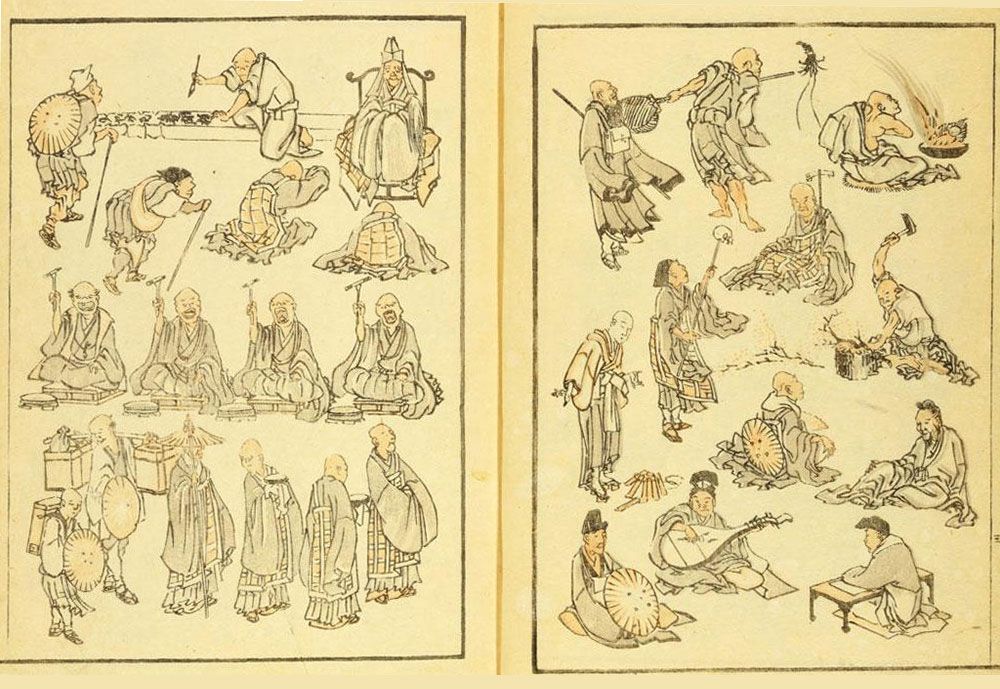Początki Mangi
Początki Mangi
Od lat badacze tematu nie są zgodni, kiedy powstała manga. Czy jest to coś, co ma lat kilkadziesiąt, sto, dwieście, a może tysiąc? Niektórzy uważają, że pierwszymi mangami były drzeworyty.
Ukiyo-e (dosłownie: obrazy przemijającego świata) to rodzaj malarstwa i drzeworytu japońskiego, funkcjonujący w okresie Edo (od połowy XVII wieku do początków okresu Meiji w drugiej połowie XIX wieku).
Jednym z miejsc, gdzie można obejrzeć drzeworyty jest Muzeum Ukiyo-e Kurashiki, gdzie można obejrzeć słynne dzieła mistrza Kuniyoshi.
Wiele drzeworytów znajdziecie w internetowej kolekcji Muzeum:
https://ukiyo-e-kurashiki.jp/?lang=en
Najsłynniejszym twórcą drzeworytów jest Hokusai. Z dziełami mistrza zapoznacie się pod tym linkiem:
https://niezlasztuka.net/o-sztuce/hokusai-katsushika-wielka-fala-w-kanagawie/
The Begining of Manga
Some researchers trace back the origins of comics to cave paintings. The situation is similar with manga. Brigitte Koyama-Richard estimates the history of manga comics at one thousand years, although she cannot support this theory... When inquired about the first work of the genre, she points to the emakimono, or ‘scroll’, called Chōjū jinbutsu giga (Caricatures of Anthropomorphic Birds and Beasts), a 12th century work depicting animals in playful poses imitating humans. Kanta Ishida proposes another work, Shigisan engi emaki (The Scroll on the Foundation of the Temple on Mount Shigi), as the progenitor of manga. What is significant is that a narrative can be found in the scroll. However, Ishida believes that the scrolls and contemporary comics cannot be directly connected.
Hokusai
Other scholars date the origin of manga to the 19th century, or even more specifically to the year 1814. This is when Katsushika Hokusai (1760–1849) published his first volume of sketches entitled Manga. Pointing to this collection, or the woodcuts of the time, as the forerunners of the genre is not justified. Hokusai did apply the term manga to his art, but most of his works lack narrative continuity and the distinctive features of comics. Notably, even at that time, art had a mass character in Japan. Once a woodblock had been prepared, it could be fairly quickly and easily reproduced in multiple printed copies.
Global impacts
The origins of Japanese comics can be traced back to satirical publications issued around the time of the Meiji reform (1868). Japan reopened to the world and to the gradual influx of Western satirical magazines and even illustrators themselves, such as Charles Wirgman who published the magazine called ‘Japan Punch’.
From the year 1890 onwards, the newspaper ‘Jiji-shinpō’ (‘Current Events’) published sequences of satirical drawings by Ippyō Imaizumi, who had come across caricatures in the United States. He later published Ippyō mangashu shohen, or ‘Ippyō Manga Collection: Volume 1’.
The Cat
At the beginning of the 20th century, a considerable number of publications appeared that were entertaining but also propagandistic in character. An interesting example is Norakuro (‘Stray Black’) by Suihō Tagawa (1899–1989). It is a story of anthropomorphic animals, with the main character being a black cat joining an army of dogs. The series was published from 1931 to 1981! The cat became an informal mascot of the propaganda and, similarly to modern manga even before the Second World War, it inspired numerous gadgets and, years later, also an animated version.
Походження манґи
Деякі науковці пов'язують походження коміксів з наскельними малюнками. Те саме можна сказати і про манґу. Бріджит Кояма-Річард налічує тисячі років історії коміксів манґа, хоча й не може підтвердити свою теорію... Як на перший твір цього жанру вона вказує на emakimono, або «сувій» Chōjū jinbutsu giga (Карикатури антропоморфних птахів і створів), твір 12-го століття, на якому зображені тварини в кумедних позах, що імітують людей.
Канта Ішіда представляє інший твір, Shigisan engi emaki (Сувій про появу храму на горі Шінґі), як прототип манґи. Важливо, що в сувої можна знайти наратив. Однак Ішіда вважає, що сувої та сучасні комікси не можна безпосередньо пов'язувати.
Хокусай
Інші дослідники датують виникнення манґи 19 століттям, а точніше 1814 роком, коли Хокусай Кацушіка (1760-1849) опублікував перший том ескізів під назвою Манґа. Посилання на цю збірку чи тогочасні ксилографії як на прототипи жанру не є виправданими. Хокусай дійсно застосовував назву манґа до своєї творчості, але його роботи здебільшого позбавлені наративної послідовності і не мають характерних ознак коміксів. Важливо, що вже тоді мистецтво в Японії мало масовий характер. Після того, як гравюра на дереві була зроблена, її можна було досить швидко і легко розмножити в багатьох відбитках.
Світовий вплив
Витоки японських коміксів можна простежити у сатиричних виданнях, що з'явилися після реформи Мейдзі (1868). Японія знову відкрилася для світу, і почали туди потрапляти західні сатиричні журнали і навіть самі ілюстратори, такі як Чарльз Віргман, який видавав журнал Japan Punch.
Газета «Jiji shinpō» (Поточні події) з 1890 року публікувала послідовні сатиричні малюнки Іппіо Імаїдзумі, який натрапив на карикатури у Сполучених Штатах. Пізніше він опублікував Ippyō mangashu shohen, або Збірник манґи Іппіо, перший том.
Кіт
На початку 20-го століття почала виходити значна кількість творів, які мали розважальний, але водночас і пропагандистський характер. Цікавим прикладом є оповідання Norakuro (Безхатній чорний) Суіхо Таґави (1899-1989). Це історія про антропоморфних тварин, де головним героєм є чорний кіт, який приєднується до армії собак. Серія виходила з 1931 по 1981 рік! Кіт став неформальним талісманом пропаганди і, як і у випадку з сучасною манґою ще до Другої світової війни став величезною кількістю гаджетів, а пізніше отримав свою анімовану версію.


